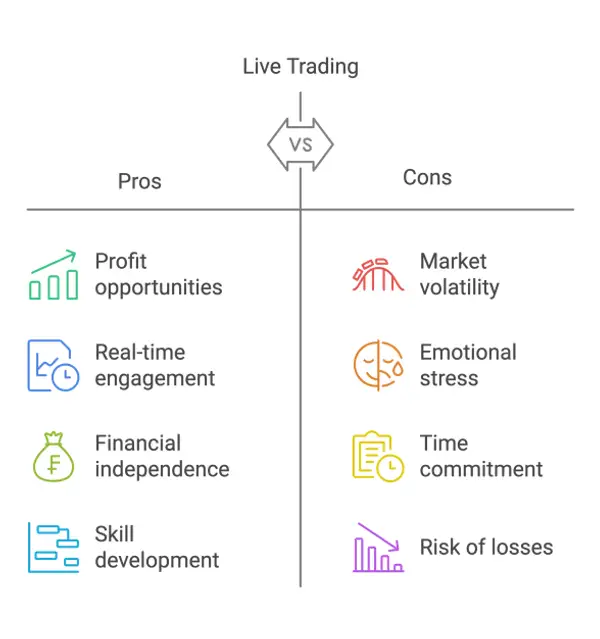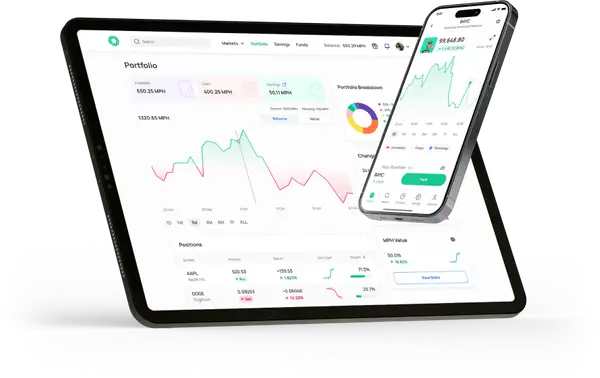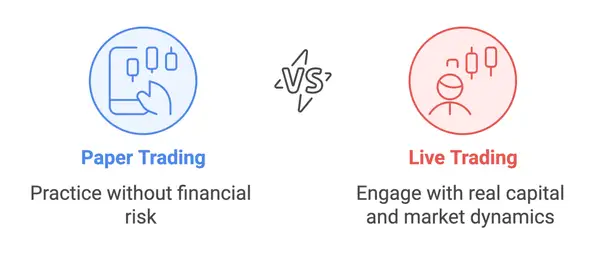Live Trading Guide: Terms, Tools and Tips for Winning Strategies

The term live trading can be intimidating, but mainly when we refer to it as a live trade, it simply means a trade that happens in real time, with real money, in the open market. No simulations, no practice rounds, just you, the market, and your strategy in action.
For many, live trading is where the excitement begins. It’s where traders test their skills, react to market movements, and seize opportunities as they unfold. But let’s be real, live trading isn’t just about the rush. It comes with risks, challenges, and a learning curve that separates the pros from the impulsive traders. Understanding how live trading works, what it promises, and how to navigate it wisely is necessary when success is desired.
So, if you’re looking to step into the world of live trading with confidence, this guide will break it all down: key terms, tools you will need, common pitfalls, and expert tips to help you trade smarter. Let’s dive in.
What is Live Trading?
Live trading is the real time buying and selling of financial assets, such as stocks, forex, crypto, or commodities, using actual money. Unlike simulated trading (or paper trading), live trading happens in an open market where prices change by the second, and every trade carries real financial risk.
When you place a live trade, you're entering the market as it moves. Your profits or losses depend on how well you time your trades, manage risk, and react to price changes. It’s the stage where traders put their strategies to the test, without the safety net of virtual funds.
For some, live trading is about generating income or building wealth. For others, it’s an active way to participate in the markets and take control of their financial future. But while the potential rewards can be exciting, live trading also requires discipline, strategy, and a good understanding of market behavior.

What You Need for Live Trading
Jumping into live trading without knowing the basics is like trying to drive a race car without understanding the pedals. You might get it moving, but chances are, you’ll crash before the first turn. To trade confidently, you need to know the key terms and the tools that make live trading smoother (and a lot less stressful).
Key Terms
If you're curious to explore the theory behind these concepts, simply click on each term to access in-depth guides on fundamental trading principles.
- Bid and Ask Prices: The bid is the highest price buyers are willing to pay for an asset, while the ask is the lowest price sellers are willing to accept.
- Spread: The difference between the bid and ask prices. Essentially the cost of entering a trade.
- Slippage: The difference between the expected price of a trade and the actual price at which it is executed, often caused by market volatility.
- Leverage: Borrowed funds used to increase the size of a trade, magnifying both potential gains and losses.
- Stop-Loss Order: A pre-set order to sell an asset if it falls to a certain price, designed to limit losses.
Key Tools
- Trading Platform: Software that allows you to analyze markets, execute trades, and manage your portfolio. Platforms like Morpher offer a user-friendly experience with zero commission trading.
- Charts and Indicators: Visual tools like candlestick charts and indicators (e.g., RSI, moving averages) help traders analyze market trends and timing.
- News Feeds: Staying informed about economic events, earnings reports, and market news can give you an edge.
Sounds like a lot? The good news is, you don’t need to piece everything together from different sources. Instead of juggling multiple tools, Morpher gives you everything in one seamless platform:

TradingView Powered Advanced Charts: Mark, analyze, and save your strategies with pro-level charting.
Morpher AI: Get real-time insights on your favorite assets, so you never miss an opportunity.
Trade Anywhere: Access all features from your phone, so you’re always in control. Download here.
Zero Fees, Zero Commissions: No hidden costs. No monthly charges. Just pure trading. Learn more about our fees policy here.
The more you trade, the more you'll realize how much commissions eat into your profits on other platforms. Morpher lets you keep what you earn.
Sign up now and see the difference for yourself! 🚀
What Does Live Trading Promise?
The allure of live trading lies in its potential rewards. Here’s what draws traders to the live action:
- Profit Opportunities: With markets open around the clock (especially in forex and crypto), there’s almost always a chance to capitalize on price movements.
- Real-Time Engagement: Live trading is dynamic and engaging, offering the thrill of decision making in the heat of the moment.
- Financial Independence: Many traders aspire to replace traditional income streams with profits from live trading.
- Skill Development: The real-time environment sharpens decision making, risk management, and analytical skills.
Challenges of Live Trading
As exhilarating as live trading can be, it comes with its own set of challenges:
- Market Volatility: Prices can change fast, often in unexpected ways. This is especially true in crypto, where big swings are common, so live traders need to stay extra cautious.
- Emotional Decisions: Fear, greed, and stress can cloud judgment, leading to poor choices.
- Risk of Losses: Every trade carries financial risk, and losses are inevitable.
- Technical Issues: Platform downtime, slow execution, or internet interruptions can disrupt trades.
- Overtrading: The temptation to trade excessively can lead to burnout and capital depletion.
Recognizing these challenges is the first step to overcoming them. Successful traders are those who embrace the realities of live trading while finding ways to navigate its pitfalls.
Live Trading vs. Paper Trading
For beginners, paper trading is often the first step. It’s a simulated environment where trades are executed with virtual funds, allowing traders to practice strategies without financial risk. While paper trading is invaluable for learning, it differs significantly from live trading.

- Risk: Paper trading involves no real money, removing emotional pressure. In live trading, your capital is at stake.
- Execution: Live trading accounts for slippage, spreads, and market liquidity, whereas paper trading doesn’t always reflect these factors.
- Emotions: The psychological impact of losing (or gaining) real money is absent in paper trading.
Both forms of trading have their place. Use paper trading to refine strategies, but transition to live trading when you’re ready to face the full spectrum of market realities. Just keep in mind that paper trading is not real.
Top 5 FAQs About Live Trading
1. Can I make a living from live trading?
Yes, but it’s not easy, and it’s not instant. Professional traders treat trading like a business, with strict risk management and consistent strategies. Many traders start part-time while refining their skills before going full-time. The key is steady, repeatable gains rather than chasing big wins.
2. How long does it take to become a profitable live trader?
There’s no universal timeline, it depends on your learning curve, strategy, and discipline. Some traders take months, others take years. The best way to speed up the learning process is by practicing with a small live account, keeping a trading journal, and analyzing both wins and losses.
3. What’s the biggest mistake new traders make in live trading?
Overtrading and lack of risk management. Many beginners trade too often, thinking more trades equal more profits. Others risk too much on a single trade, wiping out their account with one bad move. The best traders know when not to trade and focus on quality over quantity.
4. How much money do I need to start live trading?
You can start with as little as €10 on platforms like Morpher, thanks to fractional trading. However, for a more structured approach, many traders start with at least a few hundred euros to have flexibility in their trades and manage risk properly.
5. What type of assets should beginners trade in live markets?
Stocks and major forex pairs are often the best for beginners, as they tend to be more stable than cryptocurrencies or highly leveraged instruments. The key is to stick with what you understand, if you know a company, industry, or sector well, you’ll be better equipped to trade it successfully.
Bonus: Can you live trade on Morpher?
We think you know the answer by now. We won’t overwhelm you by repeating the same points again. Heard enough?
Sign up on Morpher and see what live trading feels like, on your own terms.

Disclaimer: All investments involve risk, and the past performance of a security, industry, sector, market, financial product, trading strategy, or individual’s trading does not guarantee future results or returns. Investors are fully responsible for any investment decisions they make. Such decisions should be based solely on an evaluation of their financial circumstances, investment objectives, risk tolerance, and liquidity needs. This post does not constitute investment advice.

Painless trading for everyone
Hundreds of markets all in one place - Apple, Bitcoin, Gold, Watches, NFTs, Sneakers and so much more.

Painless trading for everyone
Hundreds of markets all in one place - Apple, Bitcoin, Gold, Watches, NFTs, Sneakers and so much more.









